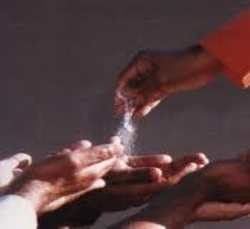In Addition
Obj 10 Sprawa 2
March/April 2019
1. Health article
Prevent and counter cough
“There is a limit and a balance that every limb and organ has to maintain. Insufficient or improper food will endanger this balance. An occasional cough helps to strengthen the lungs and to clear them of extraneous matter, but fits of coughing are positive signs of illness. Eat in moderation and live long.” …Sri Sathya Sai Baba.1
1. What is cough?
Cough is our body’s natural reflex to clear our throat and airways of irritants and prevent infection. An occasional cough is considered normal and healthy. It can be annoying but it helps our body to protect and heal itself. If it persists, it should be addressed immediately.2,3,4
2. Nature, causes, and types of cough
Cough can be acute or chronic. It is considered acute if it starts suddenly and lasts up to 2 to 3 weeks. In some cases it may last up to 8 weeks. Cough is termed chronic if it goes on for more than 8 weeks in adults and 4 weeks in children.4
Causes of acute cough: Smoke, allergens such as pollen, fungus, or mould spores found in and around homes on moist surface, or dust can irritate the nerve endings in the airways and produce coughing.2 It could also be due to a common cold or a contagious respiratory tract infection caused by flu virus or by bacteria.2-7
Causes of chronic cough: It can be caused by gastroesophageal reflux disease (GERD), sinus infection or allergies, chronic lung condition like asthma or bronchitis, or chronic obstructive pulmonary disease (COPD). Chronic cough in old age is mostly due to acid reflux.2 It could be due to medicine one is taking.2-7
A stubborn cough called chronic refractory cough is also associated with psychological factors, such as low mood, negative illness perceptions, and fatigue.8
Broadly speaking, there are two types6,7of cough - dry and wet:
Dry cough is due to irritants, like, smoke, medicines, respiratory infection in early stages, or progressive lung disease like pulmonary fibrosis. In dry cough there is no discharge of phlegm.6,7
Wet cough or a chesty cough, also called productive cough, often follows a common cold with throat infection and could also be due to infectious bronchitis, pneumonia, tuberculosis, or heart failure with fluid in the lungs. It discharges mucus. Mucus is essentially produced everyday by the mucus glands located on the mucous membrane that line multiple organs, namely, nose and sinuses, mouth, throat, lungs, and gastrointestinal tract in order to clear the airways and to prevent critical organs from drying out. It acts as a trap for irritants and contains antibodies and enzymes to fight infection. It is noticeable only during an illness. In an illness, secretion from the lower airways of the respiratory system, when expelled by coughing, is referred to as phlegm. “Sputum” and “Phlegm” are used synonymously, but in medical parlance, phlegm, when taken as a sample for testing, is known as sputum. Thick sticky mucus or phlegm implies that dehydration and/or infection is progressing. Its colour would indicate the underlying illness. Colour may change even within a day.6,7,9-11
Colours of phlegm: Thin and clear mucus is considered normal and healthy so long as it does not affect our daily life. Clear phlegm is caused by nasal allergy, hay fever, viral bronchitis, or viral pneumonia. If there is cold, flu, sinusitis, bronchitis, or pneumonia, the colour of phlegm could be yellow progressing to green, indicating growing infection. White phlegm is caused by allergies, asthma or COPD, viral infections, GERD, or congestive heart failure. Grey or charcoal phlegm is found in cases of fungal infection and black lung disease, in smokers and those who work in or near coal mines. Rusty colour (of old blood) is a sign of chronic lung disease. Red colour could be due to blood discharge indicating infection and also a disease like cancer.12,13
Some infectious coughs:
Croup is a viral throat infection in children under the age of 5. It is characterised by barking cough with noisy breathing due to inflammation of voice box, wind pipe, and airways. Worse at night, this normally gets settled in 2-5 days. It may sometimes last longer.14,15
Whooping cough is an acute, highly contagious respiratory tract infection caused by bacteria. It may last 6-8 weeks with flu like symptoms. It can be prevented through vaccinations. It occurs mostly in infants before they are vaccinated or those whose immunity is low or faded due to old age or disease.16,17
3. Treatment of cough
Cough is not a disease in itself. It is a symptom of an underlying condition; the most common symptom of a respiratory disorder.18 Vigorous cough may cause pain in ribs and chest, sleeplessness, headache, vomiting, or incontinence. One may consult a physician if cough is severe or lasts more than 3 weeks, or if there is blood in sputum, shortness of breath, consistent chest pain or tightness in chest, or breathing difficulty.4-6 A practitioner should ask pertinent questions before treating a cough.18
Some home remedies:
- Steam inhalation for wet cough, salt water gargle to soothe the throat, and adequate hydration to clear the toxins.21
- Natural cough syrup made by mixing honey in warm ginger extract.19
- Herbal cough syrup made from thyme and ivy leaves has been found to give quick relief, more rapidly than a placebo syrup for acute bronchitis.21 Thyme is an officially approved cough treatment and remedy in Germany.22 Adding marshmallow root to the syrup would effectively relieve coughs according to a study, though there could be mild stomach upsets due to the root. It could be offset by drinking more fluids.21
- Black pepper (½ teaspoon) with ghee (clarified butter) on full stomach, at least 2-3 times a day, to clear chest congestion.20
- Herbal tea made from tulsi (basil) leaves and ginger, mixed with honey. One may simply chew tulsi leaves throughout the day for faster recovery.19
- Warm tea made from ¼ teaspoon each of mulethi (liquorice), cinnamon, and clove powder and honey twice a day would work wonders.20
- Flax seeds tea with honey and lemon juice.22
- Honey is more effective than over-the-counter medicines, according to a 2007 study conducted at Penn State College of Medicine.20 Raw honey is considered as one of the best remedies for cough. Care should be taken that honey is used only with lukewarm fluids and not in hot water or hot milk.23
Special care for little children: Cough is the most common paediatric problem. This needs to be addressed carefully. Studies have not supported use of medications for symptomatic cough relief in children, at least till the age of 6. Antibiotics will have no effect on viral infections; they might cause side effects that could be more distressing than cough itself. Accurate diagnosis is more important. 18,24,25
Some specific home care for children include:
- Steam therapy is the best option followed by rest.27
- Half a cup of Pomegranate juice mixed with pippali (long pepper), and ginger or pepper powder is known to be a wonder remedy for kids.20
- Apple cider vinegar mixed with crushed ginger can cure a cough. Sucking a lemon slice will also give relief.27
- A child’s head may be slightly elevated when sleeping by raising one end of the mattress. However, babies under one and a half years should not sleep with any pillows.28
- Honey can be recommended as a single dose of 2.5 ml before bed-time for cough in children over one.26 No honey to be given for a child less than one as it is known to cause bacterial infection called botulism in infants.27,28
4. Prevention and precautions
A person with a tendency to catch cold and cough may regularly take a suitable home remedy to prevent the onset or its intensity.
- Natural antibiotic of warm milk/water with turmeric and honey before bed-time. One may consume one teaspoon of turmeric powder mixed with honey three times a day.19
- Heart-leaved moonseed (giloi) juice every morning, 2 tablespoons with water, to build immunity and to balance the 3 doshas (fundamental bodily bio-elements or humours) known as vata, pitta, and kapha in ayurveda.20
One may also refer to home remedies for fast relief from common cold and cough given in earlier newsletter.29 Acidity, a major cause of cough in elders, should also be prevented through proper lifestyle, especially diet and exercise.30
Prevent spreading of infection through proper hygiene. One should sneeze or cough into a thick tissue or cloth and also wash hands well. The tissue should be discarded and reusable cloth should be washed properly.29 These are essential as infection spreads in no time through droplets. Cold and cough spread fast due to carelessness.
Precautionary measures include avoiding close contact with the sick, staying home during sickness, covering nose and mouth, avoid touching the eyes, nose, or mouth, and washing hands properly. A smoker may quit smoking with the help of support groups or networks.
Sai Vibrionics: Prevent and counter cough and its severity through vibrionics remedies. CC4.10 Indigestion, CC9.2 Infections acute, CC19.1 Chest tonic, CC19.2 Respiratory allergies, CC19.6 Cough chronic, CC19.7 Throat chronic, or any suitable combo from 108CC box. NM8 Chest, NM9 Chest TS, NM37 Acidity, NM46 Allergy-2, NM54 Spasm, NM62 Allergy-B, NM70 CB9, NM71 CCA, NM73 Croup, NM76 Dyspnoea, NM92 Post Nasal Drip, or any suitable combination using 576 cards.31
References and Links:
- http://www.sssbpt.info/ssspeaks/volume15/sss15-21.pdf Sathya Sai Speaks,vol.15,21 Good health and goodness, 30 Sept.1981
- What is cough & its nature: https://www.nhlbi.nih.gov/health-topics/cough;https://www.ncbi.nlm.nih.gov/pmc/articles/PMC2532915/
- https://medlineplus.gov/cough.html
- https://www.mayoclinic.org/symptoms/cough/basics/definition/SYM-20050846; https://www.mayoclinic.org/diseases-conditions/chronic-cough/symptoms-causes/syc-20351575?p=1
- Causes of cough: https://www.health.com/health/gallery/0,,20358279,00.html
- Types of cough: https://www.health24.com/Medical/Cough/Overview/Types-of-cough-20120721
- https://www.nhsinform.scot/illnesses-and-conditions/lungs-and-airways/cough
- Psychological cause of cough: https://www.ncbi.nlm.nih.gov/pmc/articles/PMC5357770/
- Mucus, phlegm, sputum: https://www.medicinenet.com/what_is_mucus/article.htm
- https://www.everydayhealth.com/cold-flu/everything-you-ever-wondered-about-mucus-and-phlegm.aspx
- https://en.wikipedia.org/wiki/Phlegm
- Colour of phlegm: https://www.healthline.com/health/green-phlegm
- https://wexnermedical.osu.edu/blog/what-does-the-color-of-your-phlegm-mean
- Croup cough in children: https://www.healthline.com/health/croup#symptoms
- https://www.mydr.com.au/respiratory-health/croup-symptoms-and-treatments
- Whooping cough: https://www.mayoclinic.org/diseases-conditions/whooping-cough/symptoms-causes/syc-20378973
- https://www.nhs.uk/conditions/whooping-cough/
- Pertinent questions on cough: https://www.ncbi.nlm.nih.gov/books/NBK359/
- Home remedies for dry cough from online information guide launched by the Government of India:http://vikaspedia.in/health/ayush/ayurveda-1/ayurveda-for-common-disease-conditions/is-dry-cough-keeping-you-awake-find-relief-through-ayurveda
- Home remedies: https://food.ndtv.com/health/6-best-home-remedies-for-cough-to-give-you-instant-relief-1445513
- https://www.medicalnewstoday.com/articles/322394.php
- https://www.rd.com/health/wellness/natural-cough-remedies/
- https://www.slideshare.net/BhimUpadhyaya/food-body-by-sadhguru
- 2011 study on Handling cough of children: https://www.ncbi.nlm.nih.gov/pmc/articles/PMC3056681/
- 2017 study on chronic cough in children: https://www.ncbi.nlm.nih.gov/pmc/articles/PMC5427690/
- Honey for cough in children: https://www.ncbi.nlm.nih.gov/pmc/articles/PMC4264806/
- Specific home care for children: https://parenting.firstcry.com/articles/35-safe-home-remedies-for-cough-in-children/
- https://www.healthline.com/health/parenting/toddler-cough-remedy#home-remedies
- Sai Vibrionics Newsletter, Precautions and Home remedies for Combating Common Cold, paras 4 & 5, Vol 9 Issue 6
- Sai Vibrionics Newsletter, Health Tips on Acidity – Nip it in the bud, Vol 8 Issue 4.
- Soham Series of Natural Healing, Volume 5, The Diseases, Coughs, p.79. Also refer to volume 3, and Vibrionics 2018, p.116
2. Refresher Seminar, West London, UK, 6 January 2019
The seminar with 15 participants started on an elevating note with a prayer and a short meditation to maintain focus. Practitioner 02799 set the tone for the seminar by stressing on positive thoughts with a sense of surrender to Swami in order to harvest good things in life. She outlined how SVP course would open up more treatment possibilities, eg, nosodes of body fluids and allergens to prepare individualised remedies, and potentising allopathic medicines for removing their side effects. However SVP course applicants would need to demonstrate greater commitment to vibrionics by taking on administrative duties. The importance of treating chronic problems one at a time was stressed. While sharing successful cases, the need for submitting case histories with full details was noted. Some were concerned about the liquid remedies in the 108CC box becoming cloudy, possibly due to condensation in cold weather conditions. This was noted for taking suitable action in the future.
The participants discussed the need to pay attention to their own diet; then only can a practitioner guide patients appropriately. In particular, it was advised to rely on fresh fruits and vegetables and their juices and greens like moringa (drumstick) leaves. Avoiding non-vegetarian foods and replacing the five whites, namely white sugar, milk, refined salt, rice, and flour with better alternatives would help prevent digestive disorders, pains, and even cancer. Practitioner 03541 shared his personal experience how giving up white sugar not only relieved his tooth pain but also, within a week, his digestive system improved and his chronic back pain almost vanished.
It was decided after charging of the 108CC boxes to put a sticker on them with the “date of charge”. The seminar concluded with Aarti to Swami.

3. Refresher Workshop in Dharmakshetra, Mumbai, India, 9 February 2019
A highly informative and interactive refresher course, attended by 36 practitioners, was conducted by a Senior Vibrionics teacher10375 . She went through each chapter of the latest version of the AVP manual emphasising the recent updates. The participants were informed about the various initiatives including mentoring to support new practitioners. The take home points were to: commit less and work more; adhere to the promise given to Swami; give minimum but appropriate combos to expedite cure as vibrionics is very powerful, taper the dosage systematically after cure, take a preventive cycle of remedies for cleansing and for building immunity (practitioner should first follow himself), maintain patient records systematically, and promptly report details of successful cases for publication. She exhorted the practitioners to take administrative responsibilities to speed up the process of institutionalisation of vibrionics.
In his WhatsApp address to the participants, Dr Aggarwal from Puttaparthi traced the growth of vibrionics and shared how Swami had inspired, blessed, and guided the initiative of training new practitioners outside Puttaparthi, starting from Maharashtra in the year 2007. He stressed that service rendered with love and compassion, the two pillars of good service, will produce the best results for our patients.
It is a great honour for the vibrionics fraternity to receive the support of both past and current State presidents of Sai organisation in Maharashtra. While appreciating the invaluable service rendered by the practitioners, they expressed their keen interest in taking vibrionics forward in their State. This greatly inspired the practitioners to render vibrionics seva with renewed zeal.

Om Sai Ram
